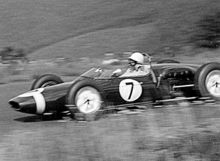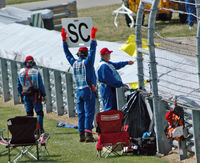The sport's title, Formula One, indicates that it is intended to be the most advanced and most competitive of the many racing formulae.
The return of racing (1950–1958)

Juan Manuel Fangio drove this Alfa Romeo 159 to the title in 1951.
The first Formula One World Championship was won by Italian Giuseppe Farina in his Alfa Romeo in 1950, barely defeating his Argentine teammate Juan Manuel Fangio. However, Fangio won the title in 1951, 1954, 1955, 1956 & 1957, his streak interrupted after an injury by two-time champion Alberto Ascari of Ferrari. Although Britain's Stirling Moss was able to compete regularly, he was never able to win the World Championship, and is now widely considered to be the greatest driver never to have won the title. Fangio, however, is remembered for dominating Formula One's first decade and has long been considered the "grand master" of Formula One.
The period was dominated by teams run by road car manufacturers - Alfa Romeo, Ferrari, Mercedes Benz and Maserati - all of whom had competed before the war. The first seasons were run using pre-war cars like Alfa's 158. They were front engined, with narrow treaded tyres and 1.5 litre supercharged or 4.5 litre naturally aspirated engines. The 1952 and 1953 world championships were run to Formula Two regulations, for smaller, less powerful cars, due to concerns over the number of Formula One cars available. When a new Formula One, for engines limited to 2.5 litres, was reinstated to the world championship in 1954 Mercedes-Benz introduced the advanced W196, which featured innovations such as desmodromic valves and fuel injection as well as enclosed streamlined bodywork. Mercedes won the drivers championship for two years, before withdrawing from all motorsport in the wake of the 1955 Le Mans disaster.
The 'Garagistes' (1959–1980)
The first major technological development, Cooper's re-introduction of mid-engined cars (following Ferdinand Porsche's pioneering Auto Unions of the 1930s), which evolved from the company's successful Formula 3 designs, occurred in the 1950s. Australian Jack Brabham, World Champion in 1959, 1960 and 1966, soon proved the new design's superiority. By 1961, all competitors had switched to mid-engined cars.The first British World Champion was Mike Hawthorn, who drove a Ferrari to the title in 1958. However, when Colin Chapman entered F1 as a chassis designer and later founder of Team Lotus, British racing green came to dominate the field for the next decade. Between Jim Clark, Jackie Stewart, John Surtees, Jack Brabham, Graham Hill, and Denny Hulme, British teams and Commonwealth drivers won twelve world championships between 1962 and 1973.
In 1962, Lotus introduced a car with an aluminium sheet monocoque chassis instead of the traditional spaceframe design. This proved to be the greatest technological breakthrough since the introduction of mid-engined cars. In 1968, Lotus painted Imperial Tobacco livery on their cars, thus introducing sponsorship to the sport.
Aerodynamic downforce slowly gained importance in car design from the appearance of aerofoils in the late 1960s. In the late 1970s Lotus introduced ground effect aerodynamics that provided enormous downforce and greatly increased cornering speeds (though the concept had previously been used on Jim Hall's Chaparral 2J in 1970). So great were the aerodynamic forces pressing the cars to the track, up to 5g, that extremely stiff springs were needed to maintain a constant ride height, leaving the suspension virtually solid, depending entirely on the tyres for any small amount of cushioning of the car and driver from irregularities in the road surface.[2]
The formation of the Fédération Internationale du Sport Automobile (FISA) in 1979 set off the FISA-FOCA war, during which FISA and its president Jean-Marie Balestre clashed repeatedly with the Formula One Constructors Association over television profits and technical regulations.
Big business (1981–2000)
1981 saw the signing of the first Concorde Agreement, a contract which bound the teams to compete until its expiration and assured them a share of the profits from the sale of television rights, bringing an end to the FISA-FOCA War and contributing to Bernie Ecclestone's eventual complete financial control of the sport, after much negotiation.The FIA imposed a ban on ground effect aerodynamics in 1983. By then, however, turbocharged engines, which Renault had pioneered in 1977, were producing over 700 bhp (520 kW) and were essential to be competitive. By 1986 a BMW turbocharged engine achieved a flash reading of 5.5 bar pressure, estimated to be "over 1300 bhp" (970 kW) in qualifying for the Italian Grand Prix. The following year power in race trim reached around 1,000 bhp (820 kW), with boost pressure limited to only 4.0 bar.[3] These cars were the most powerful open-wheel circuit racing cars ever. To reduce engine power output and thus speeds, the FIA limited fuel tank capacity in 1984 and boost pressures in 1988 before banning turbocharged engines completely in 1989.
The development of electronic driver aids began in the 1980s. Lotus began to develop a system of active suspension which first appeared in 1982 on the F1 Lotus 91 and Lotus Esprit road car. By 1987 this system had been perfected and was driven to victory by Ayrton Senna in the Monaco Grand Prix that year. In the early 1990s, other teams followed suit and semi-automatic gearboxes and traction control were a natural progression. The FIA, due to complaints that technology was determining the outcome of races more than driver skill, banned many such aids for 1994. However, many observers felt that the ban on driver aids was a ban in name only as the FIA did not have the technology or the methods to eliminate these features from competition.
The teams signed a second Concorde Agreement in 1992 and a third in 1997, which is due to expire on the last day of 2007.
On the track, the McLaren and Williams teams dominated the 1980s and 1990s. Powered by Porsche, Honda, and Mercedes-Benz, McLaren won 16 championships (seven constructors', nine drivers') in that period, while Williams used engines from Ford, Honda, and Renault to also win 16 titles (nine constructors', seven drivers'). The rivalry between racing legends Ayrton Senna and Alain Prost became F1's central focus in 1988, and continued until Prost retired at the end of 1993. Tragically, Senna died at the 1994 San Marino Grand Prix after crashing into a wall on the exit of the notorious curve Tamburello, having taken over Prost's lead drive at Williams that year. The FIA worked to improve the sport's safety standards since that weekend, during which Roland Ratzenberger also lost his life in an accident during Saturday qualifying. No driver has died on the track at the wheel of a Formula One car since, though two track marshals have lost their lives, one at the 2000 Italian Grand Prix, and the other at the 2001 Australian Grand Prix.
Since the deaths of Senna, Ratzenberger & Gilles Villeneuve, the FIA has used safety as a reason to impose rule changes which otherwise, under the Concorde Agreement, would have had to be agreed upon by all the teams - most notably the changes introduced for 1998. This so called 'narrow track' era resulted in cars with smaller rear tyres, a narrower track overall and the introduction of 'grooved' tyres to reduce mechanical grip. There would be four grooves, on the front and rear - although initially three on the front tyres in the first year - that ran through the entire circumference of the tyre. The objective was to reduce cornering speeds and to produce racing similar to rain conditions by enforcing a smaller contact patch between tyre and track. This was to promote driver skill and provide a better spectacle.
Results have been mixed as the lack of mechanical grip has resulted in the more ingenious designers clawing back the deficit with aerodynamic grip - pushing more force onto the tyres through wings, aerodynamic devices etc - which in turn has resulted in less overtaking as these devices tend to make the wake behind the car 'dirty' preventing other cars from following closely, due to their dependence on 'clean' air to make the car stick to the track. The grooved tyres also had the unfortunate side effect of initially being of a harder compound, to be able to hold the groove tread blocks, which resulted in spectacular accidents in times of aerodynamic grip failure e.g. rear wing failures, as the harder compound could not grip the track as well.
The more innovative teams have found ways to maximise this dramatic change. In 1997 an F1 Racing photographer noticed that the rear brakes of the McLarens were glowing red in an acceleration zone of the track. The magazine discovered through investigation that McLaren had installed a second brake pedal, selectable by the driver to act on one of the rear wheels. This allowed the driver to eliminate understeer and reduce wheelspin when exiting slow corners, dubbed "brake steer". Ferrari's protestations to the FIA led to the system being banned at the 1998 Brazilian Grand Prix.[4]
Drivers from McLaren, Williams, Renault (formerly Benetton) and Ferrari, dubbed the "Big Four", have won every World Championship from 1984 to the present day. Due to the technological advances of the 1990s, the cost of competing in Formula One rose dramatically. This increased financial burden, combined with four teams' dominance (largely funded by big car manufacturers such as Mercedes-Benz (DaimlerChrysler)), caused the poorer independent teams to struggle not only to remain competitive, but to stay in business. Financial troubles forced several teams to withdraw. Since 1990, 28 teams have pulled out of Formula One. This has prompted former Jordan owner Eddie Jordan to say that the days of competitive privateers are over.[5]
The manufacturers return (2000–2006)
Michael Schumacher and Ferrari won an unprecedented five consecutive drivers’ championships and six consecutive constructors’ championships between 1999 and 2004. Schumacher set many new records, including those for Grand Prix wins (91), wins in a season (13 of 18), and most drivers' championships (7).[6] Schumacher's championship streak ended on September 25, 2005 when Renault driver Fernando Alonso became Formula One’s youngest champion. In 2006, Renault and Alonso won both titles again. Schumacher retired at the end of 2006 after 16 years in Formula One.
During this period the championship rules were frequently changed by the FIA with the intention of improving the on-track action and cutting costs.[7] Team orders, legal since the championship started in 1950, were banned in 2002 after several incidents in which teams openly manipulated race results, generating negative publicity, most famously by Ferrari at the 2002 Austrian Grand Prix. Other changes included the qualifying format, the points scoring system, the technical regulations and rules specifying how long engines and tyres must last. A 'tyre war' between suppliers Michelin and Bridgestone saw lap times fall, although at the 2005 United States Grand Prix at Indianapolis seven out of ten teams did not race when their Michelin tyres were deemed unsafe for use. At the end of 2006 Max Moseley outlined a ‘green’ future for Formula One, in which efficient use of energy would become an important factor. And the tyre war ended, as Bridgestone became the sole tyre supplier to Formula One for the 2007 season.
Since 1983, Formula One had been dominated by specialist race teams like Williams, McLaren and Benetton, using engines supplied by large car manufacturers like Mercedes-Benz, Honda, Renault and Ford. Starting in 2000 with Ford’s creation of the largely unsuccessful Jaguar team, new manufacturer-owned teams entered Formula One for the first time since Alfa Romeo and Renault in 1985. By 2006, the manufacturer teams – Renault, BMW, Toyota, Honda and Ferrari – dominated the championship, taking five of the first six places in the constructors' championship. The sole exception was McLaren, which is part-owned by Mercedes Benz. Through the Grand Prix Manufacturers Association (GPMA) they negotiated a larger share of Formula One’s commercial profit and a greater say in the running of the sport.


Brak komentarzy:
Prześlij komentarz